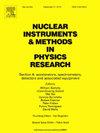Data-driven modeling of quenches in superconducting accelerator magnets
IF 1.4
3区 物理与天体物理
Q3 INSTRUMENTS & INSTRUMENTATION
Nuclear Instruments & Methods in Physics Research Section A-accelerators Spectrometers Detectors and Associated Equipment
Pub Date : 2025-07-14
DOI:10.1016/j.nima.2025.170816
引用次数: 0
Abstract
A superconductor transitions to the normal-conducting state above certain limits on temperature, current density, and magnetic flux density. This process is known as a resistive transition or quench. Superconducting accelerator magnets usually operate close to their quench limits for economic reasons and because the application requires the highest achievable field. The magnet protection after a quench in the main dipole and quadrupole magnets of the Large Hadron Collider (LHC) is based on a combination of heating elements, known as quench heaters (QH), extraction resistors, and bypass diodes. Magnet protection is achieved by safely reducing the current through the magnet to zero in a very short time, so that the hot-spot temperature in the coils does not exceed a critical value, typically around 250–300 kelvin. Additional measures for the LHC upgrade include a current-pulse protection system, in which a short pulse of current from a capacitor is fed to the windings of a superconducting coil. This method, known as Coupling-Loss-Induced Quench (CLIQ) protection, will be implemented in the NbSn quadrupole magnets of the high-luminosity upgrade of the Large Hadron Collider (HL-LHC). While the efficiency of quench heater and CLIQ systems can indeed be estimated by multiphysics simulations (thermal, electric, and magnetic), significant uncertainties remain in the nonlinear material parameters and system responses, as long as cryogenic testing and magnetic measurements are unavailable to gauge these material parameters, which are used in the numerical simulations.
In this paper, we explore a hybrid, data-driven numerical model implemented in CERN’s field calculation program ROXIE to study the efficiency of magnet protection with both quench heaters and CLIQ. This is achieved by combining statistical analysis of test data from magnets protected with quench heaters and/or CLIQ with multiphysics simulations of magnet protection using quench heaters alone. As an example of mitigating ignorance (defined in the sense of unrecognized physical effects such as superconducting filament degradation, hydraulic effects, or stress-dependent material parameters), we augment simulations without CLIQ circuits by testing data of the HL-LHC dispersion-suppressor dipole (MBH) and the inner-triplet quadrupole (MQXF) protected with both quench heaters and CLIQ. We first train the hybrid model with data from the MBH dipole and MQXF quadrupole magnets, validate the results with selected data from specific MBH magnet tests, and then estimate the hot-spot temperature of a NbSn 12-T dipole magnet (12-T Valued Engineering, 12-T VE) that is still in the design and prototyping phase.
This data-driven, hybrid modeling of quenching superconducting accelerator magnets can be viewed as an example of Model-Based System Engineering, a recently established approach for post-processing magnetic measurements. And although the CLIQ circuit response can well be simulated, we take this as an example of a delta model in which an ignored or unknown physical effect is substituted by tests and measurements.
超导加速器磁体中淬火的数据驱动建模
超导体在一定的温度、电流密度和磁通密度的限制下转变为正常导电状态。这个过程被称为电阻转变或淬火。由于经济原因,超导加速器磁体通常在接近其淬火极限的地方运行,因为应用需要最高的可实现场。在大型强子对撞机(LHC)的主偶极和四极磁体中淬火后的磁铁保护是基于加热元件的组合,称为淬火加热器(QH),提取电阻和旁路二极管。磁铁保护是通过在很短的时间内安全地将通过磁铁的电流降低到零来实现的,因此线圈中的热点温度不超过临界值,通常在250-300开尔文左右。LHC升级的其他措施包括电流脉冲保护系统,其中来自电容器的短脉冲电流被馈送到超导线圈的绕组。这种被称为耦合损耗诱导猝灭(CLIQ)保护的方法将在大型强子对撞机(HL-LHC)高亮度升级的Nb3Sn四极磁体中实施。虽然淬火加热器和CLIQ系统的效率确实可以通过多物理场模拟(热、电和磁)来估计,但只要在数值模拟中无法使用低温测试和磁测量来测量这些材料参数,那么非线性材料参数和系统响应中仍然存在重大的不确定性。在本文中,我们探索了一个混合的,数据驱动的数值模型,实现在欧洲核子研究中心的现场计算程序ROXIE中,以研究同时使用淬火加热器和CLIQ的磁体保护效率。这是通过将使用淬火加热器和/或CLIQ保护的磁体测试数据的统计分析与单独使用淬火加热器的磁体保护的多物理场模拟相结合来实现的。作为减轻忽视的一个例子(定义为未识别的物理效应,如超导灯丝降解,液压效应或应力相关材料参数),我们通过测试HL-LHC色散抑制偶极子(MBH)和内三重态四极子(MQXF)的数据来增加没有CLIQ电路的模拟,同时使用淬火加热器和CLIQ保护。我们首先用MBH偶极子和MQXF四极磁体的数据训练混合模型,用特定MBH磁体测试的选定数据验证结果,然后估计仍处于设计和原型阶段的Nb3Sn 12-T偶极子磁体(12-T Valued Engineering, 12-T VE)的热点温度。这种数据驱动的淬火超导加速器磁体混合建模可以看作是基于模型的系统工程的一个例子,这是一种最近建立的后处理磁性测量方法。虽然CLIQ电路的响应可以很好地模拟,但我们将其作为delta模型的一个例子,在该模型中,被忽略或未知的物理效应被测试和测量所取代。
本文章由计算机程序翻译,如有差异,请以英文原文为准。
求助全文
约1分钟内获得全文
求助全文
来源期刊
CiteScore
3.20
自引率
21.40%
发文量
787
审稿时长
1 months
期刊介绍:
Section A of Nuclear Instruments and Methods in Physics Research publishes papers on design, manufacturing and performance of scientific instruments with an emphasis on large scale facilities. This includes the development of particle accelerators, ion sources, beam transport systems and target arrangements as well as the use of secondary phenomena such as synchrotron radiation and free electron lasers. It also includes all types of instrumentation for the detection and spectrometry of radiations from high energy processes and nuclear decays, as well as instrumentation for experiments at nuclear reactors. Specialized electronics for nuclear and other types of spectrometry as well as computerization of measurements and control systems in this area also find their place in the A section.
Theoretical as well as experimental papers are accepted.

 求助内容:
求助内容: 应助结果提醒方式:
应助结果提醒方式:


